Fambong Lho Wildlife Sanctuary
| Fambong Lho Wildlife Sanctuary | |
|---|---|
| Fambonglho Wildlife Sanctuary | |
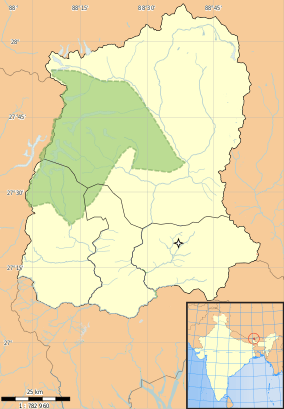 Location in Sikkim, India | |
| Location | East Sikkim District, Sikkim |
| Nearest city | Gangtok |
| Coordinates | 27°18′40.68″N 88°32′1.2″E / 27.3113000°N 88.533667°ECoordinates: 27°18′40.68″N 88°32′1.2″E / 27.3113000°N 88.533667°E |
| Area | 51.760 km2 |
| Established | 1984 |
| Governing body | Government of India, Government of Sikkim |
Fambong Lho Wildlife Sanctuary (Devanagari: फाम्बोन्ग ल्हो) is a wildlife reserve in the East Sikkim district of the state of Sikkim in India. This sanctuary is around 30 km west from Gangtok that is one hour by road from the capital of Sikkim. Total notified area of this sanctuary is around 51 square kilometres, few small hamlets are there inside this sanctuary; which are Dikchu, Pangthang, Mangan etc. This wildlife sanctuary has continuation with Khangchendzonga National Park of north sikkim. Management authority is governed by State Forest Department which comes under protected area type Wildlife Sanctuary.

.
Geography
Altitudinal Range of the Fambong Lho lies between 1524 metres to 2749 metres. At the top of Fambong Lho WLS is Chuli hamlet. No human habitat is there between the log house of Fambong Lho and Chuli trekkers hut. Gangtok is in the eastern side of this place and Khangchendzonga National Park in its west. Some riverine tributaries flowing through this sanctuary discharge in Teesta and Dikchuu river. These riverine tributaries flowing from north enriches its biodiversity. The highest point of this wildlife sanctuary is Tinjure.
Biodiversity
This sanctuary falls at the junction of Palearctic ecozone and Indomalaya ecozone, supporting a large variety of mammalian and avian fauna.
Natural History
Biomes
Inside this wildlife sanctuary, the primary biomes corresponding to the ecozone are:
- Terai-Duar savanna and grasslands of the tropical and subtropical grasslands, savannas, and shrublands biome
- Eastern Himalayan broadleaf forests of the Himalayan subtropical broadleaf forests biome
- Tropical and subtropical coniferous forests of the Himalayan subtropical pine forests biome
- Temperate coniferous forests of the Eastern Himalayan subalpine conifer forests biome
- Montane grasslands and shrublands of the Eastern Himalayan alpine shrub and meadows biome
All of these are typical of the Bhutan - Nepal - India hilly region. Forest types here include sub-alpine rhododendron forest, fir-oak forest and broad-leaved evergreen forest. This place also houses more than 740 species of flowers.
Fauna
Birds at Fambong Lho Wildlife Sanctuary include species like the hill partridge, satyr tragopan, fire-tailed myzornis, bar-throated minla, red-tailed minla, black-eared shrike babbler, scaly laughingthrush, streak-breasted scimitar babbler, rusty-fronted barwing, yellow-browed tit, red-headed bullfinch, crimson-browed finch, chestnut-crowned warbler etc. The endangered rufous-headed hornbill has been sighted here.
Mammals, which are regularly sighted in this sanctuary are barking deer, yellow-throated marten, Himalayan brown bear and red panda. Beside these, takin, red fox and musk deer are also present at higher altitudes. Some very commonly seen mammals in this wildlife sanctuary are Himalayan striped squirrel and Royle's pika of the family Ochotonidae.
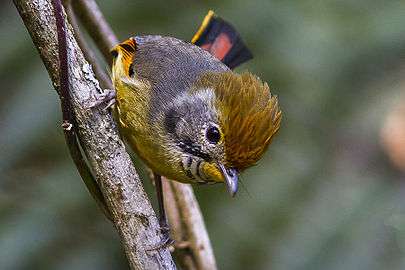 Bar-throated minla (Minla strigula strigula)
Bar-throated minla (Minla strigula strigula)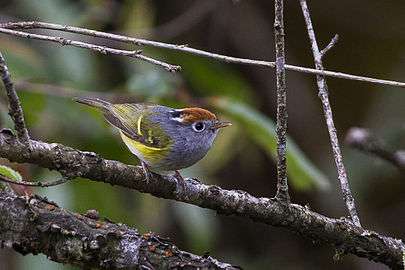 Chestnut-crowned warbler (Seicercus castaniceps castaniceps)
Chestnut-crowned warbler (Seicercus castaniceps castaniceps)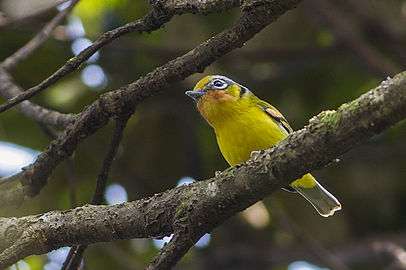 Black-eared shrike-babbler (Pteruthius melanotis melanotis)
Black-eared shrike-babbler (Pteruthius melanotis melanotis) Rusty-fronted barwing (Actinodura egertoni)
Rusty-fronted barwing (Actinodura egertoni) Rufous-vented yuhina (Yuhina occipitalis)
Rufous-vented yuhina (Yuhina occipitalis)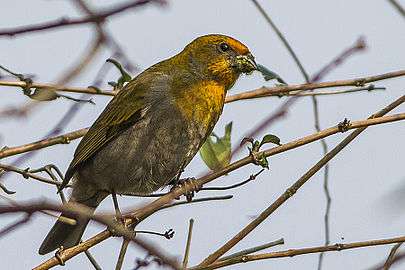 Crimson-browed finch (Pinicola subhimachala)
Crimson-browed finch (Pinicola subhimachala)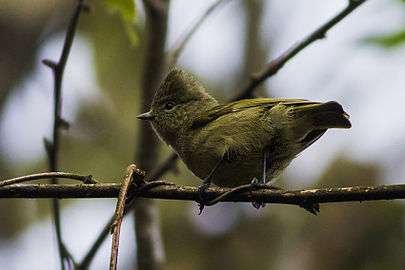 Yellow-browed tit (Sylviparus modestus)
Yellow-browed tit (Sylviparus modestus) Lemon-rumped warbler (Phylloscopus chloronotus)
Lemon-rumped warbler (Phylloscopus chloronotus)
2017 fire
On 4 February 2017, a major fire broke out at Tinjurey Ridge in the sanctuary.[1] 18 helicopters were sent to douse the fire, which took several days.
References
External links
| Wikimedia Commons has media related to Fambong Lho Wildlife Sanctuary. |